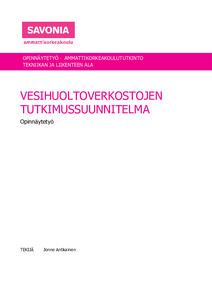Vesihuoltoverkostojen tutkimussuunnitelma
Antikainen, Jonne (2023)
Antikainen, Jonne
2023
All rights reserved. This publication is copyrighted. You may download, display and print it for Your own personal use. Commercial use is prohibited.
Julkaisun pysyvä osoite on
https://urn.fi/URN:NBN:fi:amk-2023121537549
https://urn.fi/URN:NBN:fi:amk-2023121537549
Tiivistelmä
Opinnäytetyön tavoitteena oli laatia Kuopion Vesi Oy:n verkostoyksikön tutkimusryhmälle vesihuoltoverkoston priorisoitu tutkimussuunnitelma ja -menetelmät. Tutkimussuunnitelma on tarkoitettu työkaluksi tutkimusryhmälle heidän päivittäiseen työhönsä.
Vesihuoltoverkoston tutkimussuunnitelman lähtötietoja olivat konsultin tekemä putkien riskiluokitus, aiheeseen liittyvä kirjallisuus, henkilöstön tietämys sekä verkostokartat. Työssä luotiin tutkimusryhmälle aluejaoteltu ohje, jonka mukaan ryhmä alkaa suorittaa tutkimuksia. Ohjeessa on jaettu Kuopion Vesi Oy:n toiminta-alue 31 pienempään alueeseen tutkimusjärjestykseen. Alueet jaettiin QGIS-ohjelmistolla verkoston ikä- ja kuntotietoihin perustuvaa paikkatietoaineistoa käyttäen.
Opinnäytetyön tuloksena tutkimusryhmä sai käyttöönsä aluekohtaisen tutkimussuunnitelman, joka sisälsi verkoston putkikohtaiset riskiluokat sekä verkoston iän mukaan luokiteltuna. Suunnitelma sisälsi aluekohtaisesti myös päätutkimuskohteet, yleisen rakentamisvuoden, putkimateriaalit sekä verkoston eri osien määrät metreinä. Työtä on myös mahdollista päivittää vuosittain. The aim of the thesis was to create a prioritized research plan for the water supply network for the research group of Kuopion Vesi Ltd that is in charge of the network. The research plan serves as a tool for the research group and is utilized in their daily work.
The initial data for the water supply network research plan included a consultant-made pipe risk classification, literature related to the subject, staff expertise, and network maps. A guide consisting of network districts was made for the research group, outlining the order in which the group would conduct their investigations. The guide divided Kuopion Vesi Ltd's operational area into 31 smaller districts in a research order. The districts were decided using spatial data based on the network age and condition with the help of the QGIS software.
As a result of the thesis, the research group obtained a district-specific research plan, including risk classifications for individual pipes of the network and classification based on the network age. The plan also included the main research areas in each district, the general construction year, pipe materials, and the quantities of different parts of the network in meters. It is also possible to update the guide annually.
Vesihuoltoverkoston tutkimussuunnitelman lähtötietoja olivat konsultin tekemä putkien riskiluokitus, aiheeseen liittyvä kirjallisuus, henkilöstön tietämys sekä verkostokartat. Työssä luotiin tutkimusryhmälle aluejaoteltu ohje, jonka mukaan ryhmä alkaa suorittaa tutkimuksia. Ohjeessa on jaettu Kuopion Vesi Oy:n toiminta-alue 31 pienempään alueeseen tutkimusjärjestykseen. Alueet jaettiin QGIS-ohjelmistolla verkoston ikä- ja kuntotietoihin perustuvaa paikkatietoaineistoa käyttäen.
Opinnäytetyön tuloksena tutkimusryhmä sai käyttöönsä aluekohtaisen tutkimussuunnitelman, joka sisälsi verkoston putkikohtaiset riskiluokat sekä verkoston iän mukaan luokiteltuna. Suunnitelma sisälsi aluekohtaisesti myös päätutkimuskohteet, yleisen rakentamisvuoden, putkimateriaalit sekä verkoston eri osien määrät metreinä. Työtä on myös mahdollista päivittää vuosittain.
The initial data for the water supply network research plan included a consultant-made pipe risk classification, literature related to the subject, staff expertise, and network maps. A guide consisting of network districts was made for the research group, outlining the order in which the group would conduct their investigations. The guide divided Kuopion Vesi Ltd's operational area into 31 smaller districts in a research order. The districts were decided using spatial data based on the network age and condition with the help of the QGIS software.
As a result of the thesis, the research group obtained a district-specific research plan, including risk classifications for individual pipes of the network and classification based on the network age. The plan also included the main research areas in each district, the general construction year, pipe materials, and the quantities of different parts of the network in meters. It is also possible to update the guide annually.
